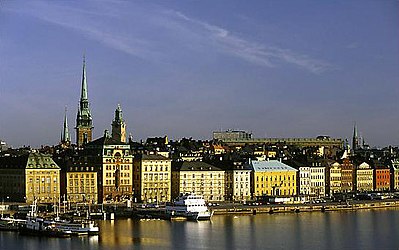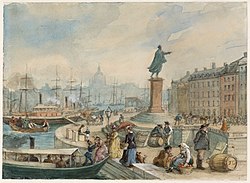Skeppsbron

Skeppsbron (
The quay
History

Skeppsbron is mentioned as Stadzbron in 1592, skeepzbroon in 1647, and finally appears as Skeppsbron in 1961. While no historical documents knows to tell when or why the decision was taken to develop the eastern waterfront of
Poles associated with an old quay preceding the existing one have been found some hundred metres from the present quay. It was called Koggabron (see cog) or stadens allmänningsbro ("the city's common bridge").[1]
The stone quay was not completed until 1854 by Nils Ericson. Today 'Skeppsbron' refers to the road passing over the quay, while the harbour area outside of it is called Skeppsbrokajen. [1]
An old fish market, once located between today's
Skeppsbron remained the vital centre for the local shipping business until the early 20th century.
Prominent buildings and addresses

Without a number :

N.20, Brandstodsbolagets hus ("House of the Fire-insurance Company"), designed by Isak Gustaf Clason (1856–1930) and built by the turn of the century 1900 in the style of Tessin the Younger. The exploitation demands of the modern era resulted in the building as being disproportionately large for the setting on its completion, a problem however dissolved by the adoption of its scale by several other buildings along Skeppsbron.[8] The Philippine Embassy in Stockholm previously occupied the building until it closed in 2012.
N.28, Skeppsbron 28, serves as the headquarters of the YWCA-YMCA of Sweden.
N.42B,
N.48, Räntmästartrappan (literally: "Interest Master's Stairs", meaning: "Stairs of the Director of the Financial Administration"), named after a building once found on the southern corner of Skeppsbron and the stairs leading up to its main entrance. The building was located south of an historical alley called Räntmästergränden which passed through the present building on the location.
The former name is also used for the area on the quay where the ferries to Djurgården departs.[9] The red granite sculpture 'Sea god' (Sjöguden) by Carl Milles (1875–1955) found on the quay, is from 1913 and depicts a monster with a broad smile pressing a bashful mermaid to his chest. The sculpture is the only of the artist's many proposals for similar sculptures carried through.[10]
Gallery

See also
References
- ^ ISBN 91-7031-042-4.
- ISBN 91-7031-042-4.
- ^ a b "Nordisk Familjebok". Project Runeberg. 1917. p. 883. Retrieved 2007-01-26.
- ^ "Stenbecks gran är världens största". Stockholm: Realtid.se. 2006-12-06. Archived from the original on 2007-09-16. Retrieved 2007-01-26.
- ^ "Skeppsbron & Stadsgården : Förnyelse för att skapa folkliv". OpenMindStockholm. Archived from the original on 2007-08-06. Retrieved 2007-01-26.
- ^ "Nordisk Familjebok". Project Runeberg. 1917. p. 885. Retrieved 2007-01-26.
- ^ "Gustav III". Explore Stockholm. 1917. Retrieved 2007-01-26.
- ISBN 91-7324-768-5.
- ^ "Stockholmiana I-IV". Project Runeberg. 1912. p. 74. Retrieved 2007-01-26.
- ^ "Konsten i Gamla stan". City of Stockholm. Retrieved 2007-02-09.[dead link]
External links
 Media related to Skeppsbron at Wikimedia Commons
Media related to Skeppsbron at Wikimedia Commons- hitta.se - Location map and virtual walk
